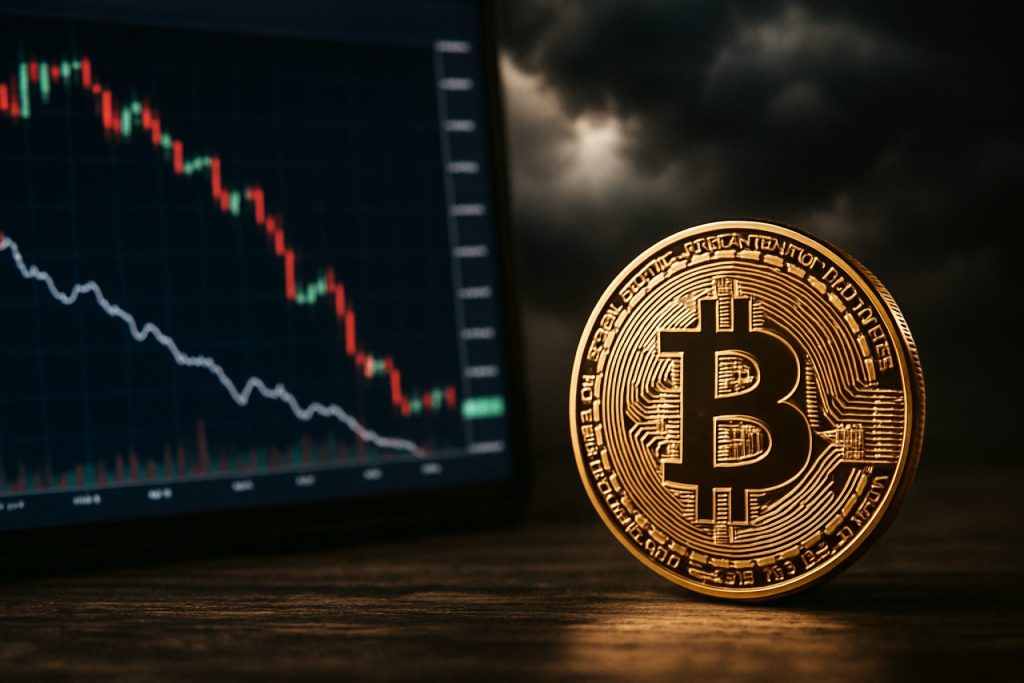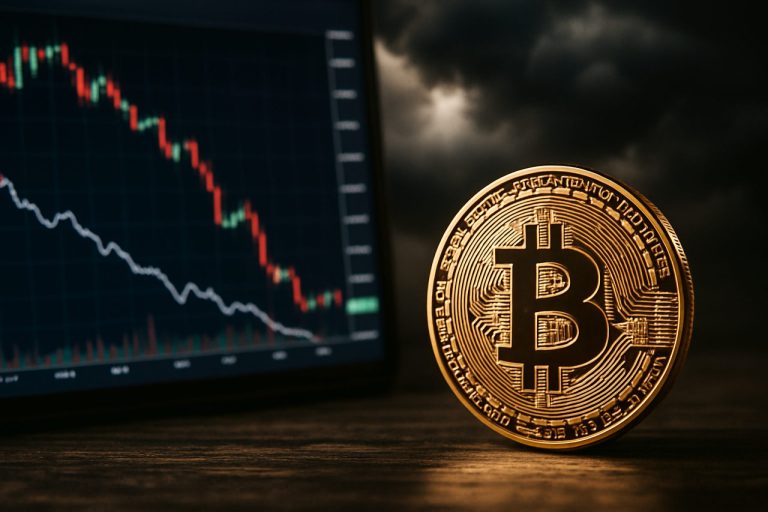
- The Labor Market Conditions Indicators (LMCI) are signaling weakening job market health, intensifying recession concerns and prompting investors to seek safer assets.
- Bitcoin is emerging as a “digital gold,” attracting attention due to its scarcity, liquidity, and decentralized, transparent nature, especially during economic instability.
- Recent surges in Bitcoin ETF inflows indicate growing institutional and retail confidence in digital assets as a mainstream hedge against macroeconomic risks.
- Traditional portfolio strategies are shifting, with investors increasingly favoring Bitcoin and other digital assets when economic uncertainty rises and labor data sours.
- The current rally in Bitcoin is seen not as a fleeting trend, but as a sign of a broader transformation in global wealth protection strategies.
A chill is running through America’s workforce—subtle to some, glaring to others. The Kansas City Federal Reserve’s Labor Market Conditions Indicators (LMCI), a trusted harbinger of job market health, slipped for the second month in a row. Signals like these have historically flashed warnings before bigger waves hit the broader economy. As the LMCI softens, conversations about recession risks buzz louder from trading floors in Manhattan to living rooms in Omaha.
While U.S. stock markets grind their gears and institutions brace for potential turbulence, something unexpected is happening: Bitcoin is shining as a beacon for nervous capital. The cryptocurrency, once dismissed by many as a fringe experiment, is now basking in surging ETF inflows—a torrent of investment that is difficult to ignore. With each new headline, more investors seem to drift away from traditional assets, clutching for a digital life raft.
A deeper look reveals why. Investors have always hunted for assets that promise stability in storms: gold, bonds, even land. But Bitcoin, sometimes dubbed “digital gold,” pairs scarcity and liquidity with the transparency and decentralization of blockchain technology. The appeal is simple yet profound; when governments shake or markets seize, a truly borderless and limited asset like Bitcoin becomes an attractive alternative.
ETF inflows offer more than just numbers—they reveal a fundamental shift in faith and strategy. The recent rush of institutional money into Bitcoin ETFs reflects a wider portfolio rotation, the financial world’s version of moving to higher ground as the rain drums harder on the roof. Suddenly, the grand experiment of cryptocurrencies is evolving into a mainstream hedge against macroeconomic pain.
Amid the rhetoric of “safe havens,” Bitcoin no longer stands alone on the digital frontier. It is part of a global search for shelter—a search that intensifies when labor market data turns sour. Investors now weigh rate cuts from the Federal Reserve as near-inevitabilities, and each data point that supports that thesis nudges them further from equities and deeper into digital assets.
For those watching the skies for storm clouds, here’s the takeaway: Bitcoin’s latest rally is not just a technical blip. It may be the beginnings of a fundamental shift in how people guard their wealth against economic shocks. As mainstream financial channels, such as Bitcoin ETFs, flood with fresh capital, an old narrative takes hold anew: uncertainty breeds opportunity, but only for the bold.
For more insights on digital assets and macroeconomics, visit CoinDesk or the official homepage of the Federal Reserve.
In these uncertain times, one truth is clear: when traditional defenses look vulnerable, the search for a new fortress begins. Right now, for many, that fortress is digital, scarce, and etched onto the blockchain.
Bitcoin’s Surprising Boom: Why Institutions Are Flocking to Crypto as America’s Job Market Wavers
Key Insights into Bitcoin’s Rise Amid Growing Economic Uncertainty
The shifting tides in America’s labor market, as signaled by the Kansas City Fed’s Labor Market Conditions Indicators (LMCI), cast a spotlight on recession risks. However, behind the headlines, another story is unfolding: Bitcoin’s role as an alternative safe haven when economic signals sour. Let’s go deeper—beyond the initial news—to reveal what’s really powering Bitcoin’s rally, how ETF inflows are changing the landscape, and what investors should know right now.
—
What’s Driving Bitcoin’s Appeal as a “Safe Haven” Asset?
Bitcoin has often been referred to as “digital gold” for good reason. Its fixed supply of 21 million coins ensures scarcity, unlike fiat currencies subject to central bank policy shifts. But there’s more beneath the surface:
– Decentralized and Borderless: Bitcoin operates on a decentralized blockchain, making it resistant to manipulation or control by any single government or organization ([source](https://www.coindesk.com)).
– Growing Institutional Adoption: Major players like BlackRock and Fidelity now offer Bitcoin ETFs, making it far more accessible to traditional investors—including pension funds, 401(k)s, and endowments.
– Transparency and Verifiability: Every transaction is immutably recorded on the blockchain, offering an unprecedented level of transparency compared to traditional finance.
– Liquidity: With 24/7 markets and strong global demand, Bitcoin can be bought and sold quickly—even when traditional markets are closed.
—
How ETF Inflows Are Changing the Crypto Market
The surge in Bitcoin ETF inflows is about more than speculation—it marks a strategic allocation shift for institutions seeking diversification and downside protection:
– Record-Breaking ETF Inflows: The U.S. saw multi-billion-dollar weekly inflows into Bitcoin ETFs in Q1 and Q2 2024 (Bloomberg).
– Wider Market Access: ETFs remove technical barriers; investors don’t need to self-custody crypto, enhancing mainstream adoption.
– Reduced Volatility: As institutional ownership increases, some analysts believe Bitcoin’s volatility may gradually moderate (ARK Invest).
—
Pressing Questions Answered
Why are investors pivoting to Bitcoin now?
Economic signals are mixed—job growth is slowing, inflation remains sticky, and the Fed is hinting at possible rate cuts. Bitcoin offers uncorrelated returns and a new diversification option.
How does Bitcoin compare to traditional safe havens like gold or bonds?
– Gold: Physical, centuries-old safe haven; typically stable but lacks crypto’s liquidity and portability.
– Bonds: Used for safety and income, but sensitive to inflation and interest rates.
– Bitcoin: Digital, portable, finite supply. Offers higher upside but with higher short-term volatility.
Are there risks to consider?
– Regulatory uncertainty remains a concern in some jurisdictions.
– Price swings can still be significant over shorter periods.
– Security of crypto holdings depends on the custodian—choose regulated ETF providers or secure personal wallets.
—
Industry Trends, Market Forecasts & Predictions
– Greater Regulatory Clarity: The U.S. Securities and Exchange Commission (SEC) is steadily providing clearer guidance on Bitcoin ETFs, encouraging wider adoption.
– Global Central Bank Digital Currencies (CBDCs): As governments experiment with CBDCs, public trust in decentralized assets like Bitcoin may grow as an alternative to state-issued currencies.
– Sustainability Push: Newer mining operations focus on renewable energy, but environmental concerns about Bitcoin’s energy use persist ([source](https://www.coindesk.com)).
– Mainstream Integration: More retailers and payment platforms are accepting Bitcoin, further enhancing its utility.
How-To Steps & Pro Tips for Getting Started
1. Assess Your Risk Tolerance: Bitcoin can be volatile—invest only what you can afford to lose.
2. Choose Your Access Point: For simplicity and security, consider regulated Bitcoin ETFs.
3. Diversify, Don’t Bet the Farm: Use crypto as a hedge, not a primary asset class.
4. Secure Your Holdings: If buying actual Bitcoin, use reputable wallets and enable two-factor authentication.
5. Stay Updated: Economic signals and regulatory changes can impact crypto prices—follow sites like CoinDesk or updates from the Federal Reserve.
—
Pros & Cons Overview
Pros
– Decentralized and portable
– Inflation-resistant by design
– Growing institutional legitimacy
Cons
– Regulatory uncertainty
– High short-term volatility
– Environmental debates around mining
—
Controversies & Limitations
– Bitcoin mining has been criticized for its environmental footprint. Though some operations use renewables, fossil fuel usage is still significant.
– Regulatory clarity varies; some countries have banned or restricted crypto, affecting global liquidity.
– Not immune to hacks—centralized exchanges have been targets, though ETFs reduce these risks.
—
Actionable Recommendations & Quick Tips
– Diversify your portfolio: Don’t go all-in on any single asset, but consider allocating 2-5% to Bitcoin if you seek inflation hedges.
– Monitor LMCI and Federal Reserve updates: These influence investor behavior and asset allocations.
– Leverage educational resources: Visit CoinDesk and the Federal Reserve for the latest research and market news.
– Stay security conscious: Use strong passwords, update your software, and consider hardware wallets for large holdings.
—
The Bottom Line
As traditional economic signals flicker and mainstream financial institutions turn to Bitcoin, the digital asset’s status as a viable safe haven strengthens. Bitcoin’s next chapter could be about stability, not just speculation—so stay informed, cautious, and ready to take advantage of the new financial frontier.
For deeper dives into crypto trends and real-time economic analysis, bookmark [CoinDesk](https://www.coindesk.com) and [Federal Reserve](https://www.federalreserve.gov).
Keyword suggestions: Bitcoin ETF inflows, digital gold, cryptocurrency safe haven, recession hedge, LMCI, institutional crypto adoption, market trends 2024, invest in Bitcoin safely, Bitcoin vs gold vs bonds.



